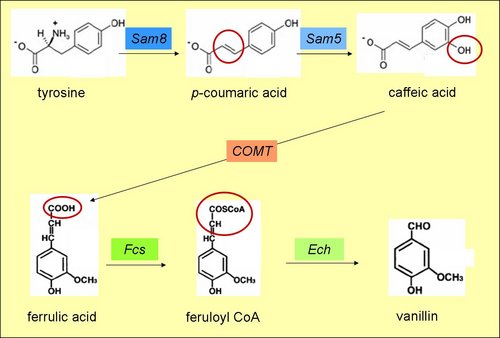Team:KULeuven/Project/Details
From 2009.igem.org
Bart Bosmans (Talk | contribs) |
(→Key antikey) |
||
| Line 16: | Line 16: | ||
[[image:Vanillin_Biosynthesis_Pathway.jpg|400px|right|Vanillin production overview starting from Tyrosine.]] | [[image:Vanillin_Biosynthesis_Pathway.jpg|400px|right|Vanillin production overview starting from Tyrosine.]] | ||
| - | == Key | + | == Key/Lock == |
[[Image:Biologie_blue_light.png|center]] | [[Image:Biologie_blue_light.png|center]] | ||
| - | + | ||
| + | The mRNA ‘key’ and ‘lock’ sequences form a pair of riboregulators. The ‘lock’ DNA is located directly upstream of the controlled gene’s RBS. It is folded into a stem-loop secondary structure which prevents access to the ribosome and inhibits translation. ‘Keys’ are expressed from separate genes (in trans) and code for sequences complementary to the lock. Upon annealing they unlock the ‘closed’ stem-loops, thereby exposing the RBS and permitting expression of the gene(s) downstream. | ||
| + | |||
| + | |||
| + | The most efficient key is a combination of the J23008 and J23009 keys. They are placed behind the blue light promoter to ensure transcription after blue light irradiation. B0015 is used as terminator. This brick consists of B0010 and BOO12 and is most commonly used. One J23078 lock is placed before Sam5 and Sam8 genes and another before COMT to guarantee maximal efficiency of the key/lock system. These genes are part of the vanillin production pathway. Therefore, after a blue light activates key-transcription, vanillin-synthesis starts. | ||
Revision as of 12:35, 31 August 2009
Contents |
Blue light receptor
The protein YcgF is a known blue-light sensor in certain E. coli strains. Upon photo-excitation it dimerizes and acts as an anti-repressor for YcgE. YcgE is bound to the promotor-region and inhibits RNA Polymerase. The dimerized YcgF interacts directly with the repressor, releasing it from the DNA and allowing transcription. We designed the [http://partsregistry.org/wiki/index.php?title=Part:BBa_K238002 BBa_K238002] part in such way that irradiation with a certain amount of blue light activates transcription of key-mRNA. To achieve this, we purified the promoter-region of E. coli MC4100. After mutating out possible restriction sites, the blr promot, [http://partsregistry.org/wiki/index.php?title=Part:BBa_K238000 BBa_K238000] part was added to the registry.
Vanillin receptor
Vanillin production
Key/Lock
The mRNA ‘key’ and ‘lock’ sequences form a pair of riboregulators. The ‘lock’ DNA is located directly upstream of the controlled gene’s RBS. It is folded into a stem-loop secondary structure which prevents access to the ribosome and inhibits translation. ‘Keys’ are expressed from separate genes (in trans) and code for sequences complementary to the lock. Upon annealing they unlock the ‘closed’ stem-loops, thereby exposing the RBS and permitting expression of the gene(s) downstream.
The most efficient key is a combination of the J23008 and J23009 keys. They are placed behind the blue light promoter to ensure transcription after blue light irradiation. B0015 is used as terminator. This brick consists of B0010 and BOO12 and is most commonly used. One J23078 lock is placed before Sam5 and Sam8 genes and another before COMT to guarantee maximal efficiency of the key/lock system. These genes are part of the vanillin production pathway. Therefore, after a blue light activates key-transcription, vanillin-synthesis starts.
 "
"



